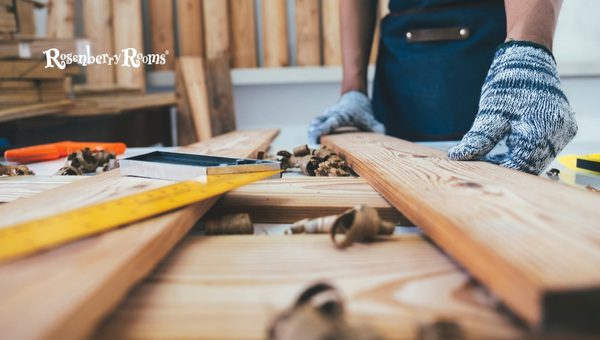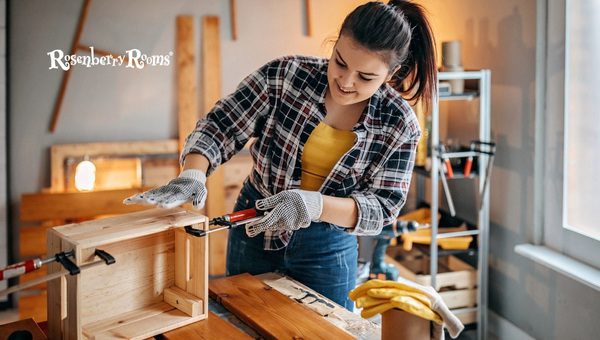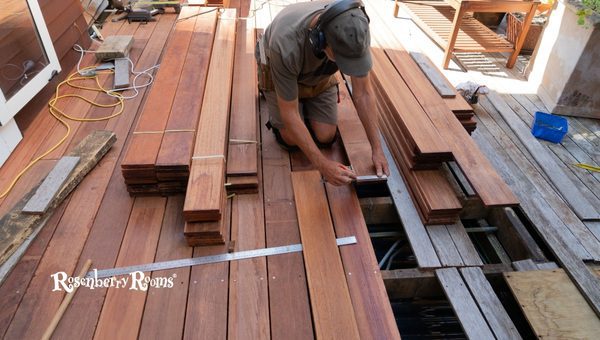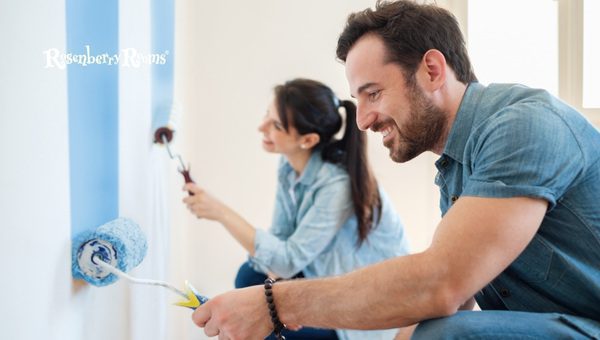Hammers, nails, and rulers – welcome to the world of do-it-yourself (DIY) shiplap! If you've always had the inkling to channel your inner handyman or woman, let me take you on a journey of discovery into shiplap design.
An excellent option for infusing your space with a dose of old-world charm and farmhouse elegance, the DIY shiplap is a must-try for every home improvement enthusiast.
This blog post is perfect for those who drool over Pinterest-worthy homes but are wary of burning a hole in our pockets.
If that sounds like you, stay tuned as I unravel the steps to satiating your urge to live in a space that mirrors your style – all by yourself!
Yes, it is possible. The time has come to roll up those sleeves and usher in enchanting transformations with DIY Shiplap as our magic wand.
Contents

Welcome to the exciting world of DIY shiplap! This might feel like a leap into the unknown, but I assure you, it's much simpler than you imagine. You can turn your home into a beautiful rustic haven with creativity, patience, and handiwork.
Before embarking on this journey, one should consider a few essential things. From understanding why shiplap is worth investing your time and efforts to getting a gist of its evolution - every bit of knowledge will add more depth to your DIY project.
Shiplap has traveled quite an intriguing journey on its pathway to household popularity. Initially utilized in shipbuilding —giving it the name 'shiplap'— this type of wood paneling was used due to its tight seal. This helped keep water out and gave ships their characteristic wooden appearance.
As time passed, individuals began recognizing its aesthetic appeal and sturdy nature. This prompted them to repurpose shiplap for building houses, particularly in coastal areas— primarily because these wooden boards were remarkably resistant against harsh weather conditions.
However, modern-day fascination with shiplap bloomed thanks primarily to Joanna Gaines from HGTV's "Fixer Upper."
She introduced this quaint style into home interiors on her show, sparking an absolute love affair with this board style.
Fast forward a few years, and now Shiplaps have been spotlighted in living rooms, mudrooms - even in kitchens across America.
Their distinct yet neutral personality makes them blend seamlessly while amplifying the space's overall appeal— all while providing us lucky DIY enthusiasts with another exciting project!

Shiplap is more than just a popular trend portrayed in reality TV shows; it can be identified by the distinctive rabbet (or groove) cut into the edges of the wood.
This aspect enables boards to fit together perfectly, creating a tight seal. The following are essential points that capture what shiplap is all about:
The type of wood you choose significantly impacts your DIY Shiplap project's final look and durability. Here's a quick guide on factors to consider when selecting your wood:
Wood grain should also be considered - clear-grade wood has little to no knots, while knotty grades offer a rustic appearance full of character but might demand extra measures during installation.
Remember - like any good story worth telling, each piece comes with its unique grains and knots telling its own story through lines across its surface - contributing towards creating a home filled with character-ridden elements that echo stories upon every gaze.
Embarking on a DIY shiplap project requires collecting specific tools and materials. This ensures a seamless process from start to finish as you incorporate the charm of shiplap into your home decor. Let's explore this tool listing for our anticipated adventure in DIY shiplap!
To ensure precision and smoothness in your work, there are specific tools you’ll need to have at your disposal.
Each tool plays its humble part in bringing your DIY shiplap wall to life. By preparing these beforehand, you mitigate any unnecessary stress mid-process!
A circular saw or a miter saw is an indispensable tool you'll need for cutting your shiplap boards to the correct size.
You can use either, but the choice between them often comes down to personal preference and the tools you have on hand.
For those awkward areas like cutting around lighting outlets or tricky corners – areas where a circular or miter saw, won't fit – that's where a jigsaw steps in.
Next up on our essential tools list is the fastener - either a nail gun or a hammer. This tool will secure your shiplap boards onto the wall.
Don't forget about including a carpenter's square in your toolkit!
A seemingly simple tool carries monumental weight in your DIY Shiplap project! This is the silent unsung hero that guides your path throughout the process.
Looking after our eyes should not be an afterthought, especially when dealing with DIY projects involving dust and wood splinters.
If you're unfamiliar with power tools such as saws and nail guns, be warned - they can be loud! This is where ear protection steps in.
Some aspects of installing a shiplap can generate dust—particularly when sawing your wood.
A stud finder helps find studs (the supporting structures behind the drywall on walls) that anchor for hanging heavier items such as our lovely shiplap!
Purchasing Tip: Look out for stud finders that give indications for live wires, too – this prevents any unpleasant surprises during installation!
Last but not least on our list of essentials is a pry bar. It's generally used where strength exertion to pull apart two objects is required.
Armed with knowledge about these necessary tools and accessories—pencil/chalk line, safety goggles, ear protection, dust mask, stud finder & pry bar—you’ve won another fragment of DIY Battle!
Each carries its unique importance resulting from its diverse functionalities—you need to make them work hand-in-hand to achieve that 'Wow' moment on unveiling your project!
In my forthcoming segments, stay put as I take you deeper into the secrets behind selecting perfect materials that complement this well-acquaintanced set of tools.
As we dive further into this exciting world of DIY shiplap, we tread upon one of the most integral parts of any DIY project: the materials needed.
Without suitable material, every step can turn into a roadblock. Therefore, I have made a list of essentials you would require if you plan to give your wall a dash of chic shiplap.
Let's break it down:
Pine boards are your ideal candidate for creating that genuine rustic look for your home. The quality and texture these pine boards provide are exquisite while offering you an economical choice compared to costlier hardwoods.
In terms of dimensions, the 1x6 or 1x8 lumber size works just right to recreate that classic shiplap charm. Using these sizes, you can create those distinct gaps or 'rabbets' which give shiplap its defining appeal.
Now you're probably asking, "Where can I get these?" Home improvement stores like Home Depot or Lowes have an excellent range of pine boards in various sizes right for your needs.
Should your project require framing due to uneven walls or specific design preferences, don't forget about 2x4s!
These boards are versatile," workhorse" lumber pieces perfect for creating frameworks on which your shiplap will sit. They provide solid structure support and ensure long-term durability for your project.
Beyond nails & screws lies another equally important element— Construction adhesive! This adhesive contributes significantly towards providing extra security to your boards while preventing any creaking noise when nailed in. It creates a firm bond between surfaces, ensuring a lasting finish.
One pro tip I follow is using an adhesive with quick-grab features like Liquid Nails. These types tend to tack up fast and hold in place better while you finish installing each panel.
Remember that selecting each material requires careful consideration of quality, aesthetics, and suitability for the undertaking job.
Let's start with the most vital component, the 2-inch finish nails that are pivotal in your DIY shiplap project.
Just remember, be careful while hammering. I always suggest using needle-nose pliers to hold the nail and prevent accidental thumb mishaps.
The secret weapon for achieving smooth, flawless shiplap is none other than - Wood filler!
A fundamental tool for refining your DIY project is sandpaper or a sanding block.
Remember! Always wear safety goggles during this process as it stirs up fine dust, which can be harmful if it enters your eyes.
One cannot underestimate the importance of primer when talking about painting Shiplap Walls.
Before you begin this phase, take special note! Ensure the surface is clean & dry before applying primer - Doing so achieves the best results!
Finish it off by using steady brush strokes, ensuring even coverage. Allow enough drying time before painting, provided final touches meet satisfaction.
Once you've successfully installed your shiplap boards, the next step would be to color them up. You've got two options here: paint or stain.
When starting your DIY Shiplap project, make sure you have enough drop cloths or plastic sheeting on hand:
The importance of having painter's tape can't be overstated in a DIY project:
If you're attaching to drywall instead of studs in your shiplap installation process, wall anchors become essential:
Adding trims such as baseboards & crown moldings is what makes your DIY Shiplap stand out:
Remember - adding these trim pieces serves both functional and visual purposes; they complete the look and extend protection to your walls!
As exciting as it sounds to pull off any DIY project--especially installing a shiplap--it is equally important to remember that each task requires correct preparation & apt tools/materials.
So plan carefully before diving into action! I hope these tips help bring out that hidden carpenter within you - good luck!
Of course, the best DIY shiplap walls go beyond mere installation. That authentic polished finish that will turn heads at family gatherings comes from refining and perfecting the installed shiplap.
Today, we'll uncover some of the secret weapons I use to give my DIY projects that professional sheen — caulk, putty knives, and corner trim.
Caulk, often overlooked by beginner DIY enthusiasts, plays a significant role in accomplishing smooth finishing touches.
The simple white stuff you see creates seamless transitions between surfaces. The purpose? To fill gaps and prevent air intrusion while giving your project a professional look.
You can find countless options on the market; I always choose silicone-based caulk. It's moisture-resistant and flexible enough to last longer than other varieties.
A prime example is the GE Silicone 2+ Kitchen & Bath Caulk— versatile, reliable, and easy to apply with excellent adhesion capabilities. Here’s how I use it:
Remember: The key here is moderation; too much caulk might give a messy look, whereas too little might make gaps visible again.
Now entering my toolbox is one of my favorite tools — the humble putty knife. These knives offer multiple uses, like scraping off old paint or applying spackling compounds or putties across surfaces (sounds like why they got their name!). They're invaluable when working with shiplap and other forms of paneling.
When choosing your putty knife, go for one with rigidity and flexibility - like this tool from Putty Knives Direct. Its blade features stainless steel, which helps resist rust over time. Here's how to use it:
Remember: Always opt for stainless steel blades. They maintain their sharpness over time plus resist rusting!
They're our wall supermodels— incredibly functional yet beautiful! These pieces add finesse to your spaces while perfectly hiding corner imperfections.
Standard ones are made from plastic (PVC), medium-density fibreboard (MDF), or solid wood. PVC trims are best in moisture-prone areas (like bathrooms).
Solid Wood works well where high durability is required (such as living & dining rooms). Generally speaking, though—you can hardly go wrong.
Many models are available from home improvement stores like Home Depot or Lowes.
To install these lovelies:
Remember: Measure twice before cutting! This way, you minimize errors inducing waste in material & effort!
So there you have it, folks - optional tools & materials used by pros that help elevate their DIY game substantially! Bear in mind - At times, what distinguishes an 'okay' job from an outstanding one lies within these subtleties.

Once we have all the necessary tools and materials, the first vital step is to inspect and prep your wall. It's crucial to ensure a smooth, clean surface on which we will install our shiplap.
With our precision preparation out of the way and safety glasses on, it's time for arguably the most gratifying part— bringing our 'shiplap' vision to life!
Cutting boards can seem daunting initially—but remember—the key lies in careful measurement and steady hands!
Remember— Safety always comes first — Always keep fingers clear from blades— Eye protection is obligatory too, while cutting.
There we go! A seemingly exhaustive yet organized list toward an immensely satisfying result—Your DIY Shiplap wall!
In my subsequent articles, we'll even delve into painting&finishing like a PRO, along with crucial insights about selecting perfect colors.
While this venture demands precision & planning—a symphony comprising all elements working harmoniously makes creating stunning aesthetics hands-on & personally rewarding.

Once the heavy lifting of installing your shiplap boards is over, it’s time to switch gears and hone in on the artistic side of this DIY project.
Below, we explore how to take your newly installed boards from plain and unpolished to a vibrant centerpiece in your living space.
Before you delve into the world of colors and brush strokes, properly prep the shiplap. Here are some helpful steps:
Your choice of paint can significantly impact the finished result - both in terms of aesthetics and durability.
Color plays a significant role in determining how your shiplap wall integrates with the rest of your interior décor. The beauty lies in its versatility; shiplap looks fantastic painted in bright hues or left like natural wood tones. Some popular choices include:
Investing time on this front now can save you much trouble later by elongating your wall’s lifespan:
Remember, DIY projects like these transform houses into homes! You've got this!
Like any home improvement project, you will bump into a few snags when tackling DIY Shiplap. Fear not; troubleshooting common mistakes and challenges is a skill that can be acquired with the proper guidance. Let me hand-hold you through some of these.
Here are a few common problems and their remedies:
Before signing off, I have one last snippet of wisdom: every project blooms on the pillar of 'patience.' Sometimes actions need to practice several times before getting them 'just right.' Home renovation projects are about enjoying the process just as much as marveling at the result.
Proper maintenance is essential to keep your DIY shiplap looking fresh and prolong its lifespan. Here are some helpful tips:
Shiplap typically needs repainting every 3-5 years, but this can vary depending on environmental factors and wear. Observe your shiplap wall — if you notice chipping, fading, or discoloration, it might be time for a fresh coat.
Minor damages like chips or scratches can easily be managed at home with these steps:
Keeping your shiplap perpetually pristine requires minimal effort – regular checks and reactions where necessary will do!
Remember, like all other home improvement projects, maintenance is as essential as installation! Don't let hard work go down the drain; let's have our beautiful shiplap serve us long and well!
Pine or cedar boards are mostly best for DIY shiplap due to their cost-effectiveness and ease of use.
Generally, shiplap boards are 3/4" thick, but you can adjust the thickness based on your aesthetic.
Traditional shiplap has very tight seams, but leaving a space of about 1/8” to 1/4" can give it a distinctive look.
It's easier to paint it beforehand; however, after installation, you may need to touch-up spots where nails have been filled or areas were damaged.
Yes, you can install shiplap directly over drywall. Just ensure the wall is smooth and prepped correctly before installation.
Pat yourself on the back for making it this far. Inching closer to your dream aesthetics has never been this accessible, thanks to the delightful and engaging world of DIY shiplap walls.
It's clear that with some grit and patience, you can take bold strides toward transforming your preferred space into a haven reminiscent of rustic elegance and old-world charm.
Let's remind ourselves that the journey does not end with installation; it extends beyond - into meticulous maintenance to keep your creation looking as good as new for longer.
The answers lay in an amalgamation of diligent cleaning, timely repainting, and quick yet effective damage control.
Undeniably, DIY shiplap is not just a project but an enduring relationship between you and your home where small contributions can yield significant results.
So gear up, equip yourself with my comprehensive guide here, and embark on this rewarding venture.